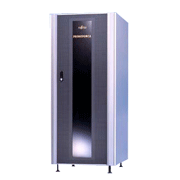This was Fujitsu’s new mainframe configuration with a multi-server structure combining features from the GS8000 series and open platforms.*1 Fujitsu announced the PRIMEFORCE in May 2000 in a configuration aimed at simplifying construction of Internet-enabled corporate IT systems while taking advantage of mainframe resources. The PRIMEFORCE ran on processors fabricated with 0.18 micron CMOS technology.
The PRIMEFORCE and the incorporated UNIX/IA server were connected with a 100 Mbps Ethernet, and time synchronization and power-supply linkage were possible. And shared disks meant that data could be transferred and shared between servers at speeds faster than over the LAN.
- *1. Either a UNIX server or an IA server (PC server). IA: Intel architecture.
| Model name | 8010C | 8020C | 8030C | 8040C | 8010M | 8020M | 8030M | 8040M |
|---|---|---|---|---|---|---|---|---|
| Introduced | May 2000 | |||||||
| Magnetic disk type | Internal | External | ||||||
| Relative performance* | 1 | 2.0 | 3.0 | 4.0 | 1 | 2.0 | 3.0 | 4.0 |
| No. of CPUs (CMOS technology) | 1 | |||||||
| Main memory capacity | 256MB - 2GB | |||||||
| Channels | 56 max. | |||||||
| Open network adaptors | 0 - 2 devices | |||||||
| Encryption processors | 2 max. | |||||||
| Internal system memory | 0 - 256MB | |||||||
| Internal shared disk memory | 0 - 119GB | |||||||
| Internal LAN | 100 Mbps Ethernet x 1, 10 Mbps Ethernet x 1 | |||||||
| No. of UNIX/IA servers | 1 - 8 | |||||||
| Power-supply control linkage unit | One standard equipped (second and subsequent units were optional) | |||||||
| Time synchronization unit | Optional | |||||||
*Taking the performance of the 8010C as the baseline for internal disk models and the 8010M as the baseline for external disk models.
The specifications above were correct at the time the products were announced. Some specifications were later revised due to product upgrades.


